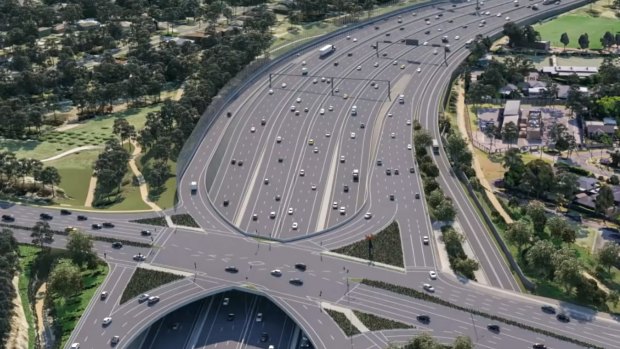By Clay Lucas and Timna Jacks

The widened Eastern Freeway as it passes Doncaster Road.Credit: Victorian Government
The proposed upgrade of the Eastern Freeway for the Andrews government’s North East Link will see it widened to at least 12 lanes - and as wide as 24 lanes in sections.
The dramatic expansion of the freeway, which is now between six and 10 lanes, is expected to shave up to 11 minutes off trips on the Eastern.
But the road widening plan has been criticised by transport and planning experts, the opposition, and councils on either side of the Eastern Freeway, where 12.7 hectares of parkland will be permanently lost.
Transport experts warned the $15.8 billion North East Link was a short-sighted solution to population growth and would only increase the city’s dependence on cars. “It doesn’t make any sense. We will be the size of London and London doesn’t have new freeways,” Monash University transport studies professor Graham Currie said.
Government documents outlining the road expansion, to start next year, also show a widely praised underground rail link to Melbourne’s CBD is not expected to be finished within the next 18 years.
"Metro Tunnel 2 was not included in the modelling, as it is anticipated to be completed beyond 2036," the reports said.
The North East Link will create an orbital freeway around Melbourne, and carry a projected 135,000 vehicles daily by 2036.
The government expects it will shift around 30,000 vehicles off arterial roads, but official reports admit it would drive up car numbers across the network, especially on roads in the city’s north.
“The number of vehicles travelling on the freeway network would increase with North East Link,” the reports, released as part of the road’s upcoming environmental assessment, state.
The government wants to expand the Eastern because an extra 100,000 vehicles from the North East Link will be funnelled onto the freeway.
Much of the expansion of the freeway is due to three lanes of a new "expressway" being added in either direction, in a bid to speed up traffic.
The freeway will be widened from six lanes to at least 13 between Tram and Middleborough roads. With ramps, it will stretch to 20 lanes. Several parks here including the Koonung Creek Reserve will be carved out to make space.
The Planning Institute of Australia joined Manningham and Boroondara councils in condemning the parkland loss, saying any open space lost needed to be offset elsewhere. And institute state president Laura Murray said widening the Eastern was Melbourne again being “designed around the car” instead of public transport.
Melbourne’s north-east is particularly car-dependent, with an absence of rail confining many commuters to their car. The government's planning documents show the North East Link will even see nearly 6000 people leave the train network, and use cars or buses instead.
A government spokeswoman said widening the Eastern Freeway would accommodate current and future traffic volumes, and would also include new dedicated bus lanes.
“The Eastern Freeway will be massively improved to help North East Link do what it needs to do - take trucks off local streets,” she said.
Opposition transport infrastructure spokesman David Davis said that while the Opposition supported the link, any loss of parkland must be properly thought through. “They can’t just tear out parkland.”
Monash’s Professor Currie said bus lanes like those promised were needed but could be left out in the final stages of major road projects. “To make the projects more acceptable, they often sugar coat them with claims of public transport expansion and then don’t do them.”
Jago Dodson, professor of urban policy at RMIT University, also said building a road like the North East Link that would generate an increase in car usage.
“If you look at where Melbourne is heading, it’s towards the failed situation of Sydney where they try to reconcile the incoherence of planning by building large mega projects.”